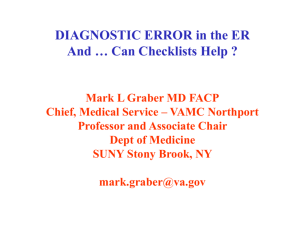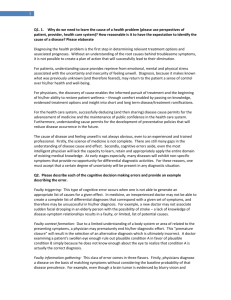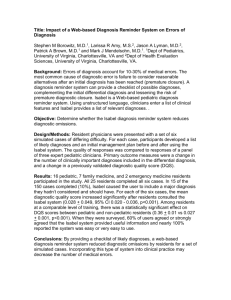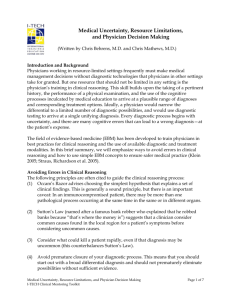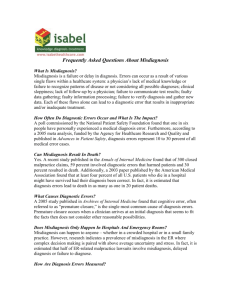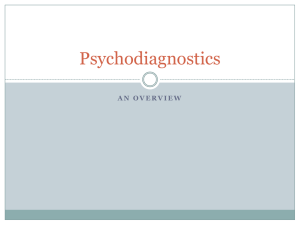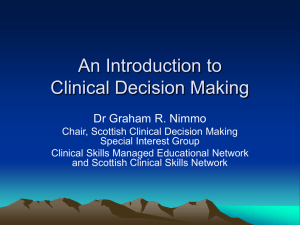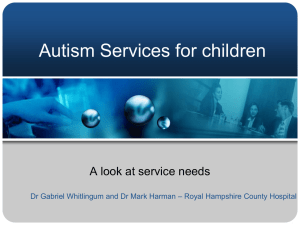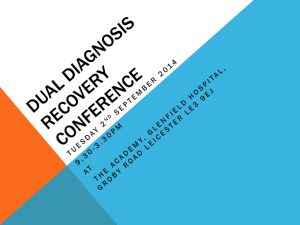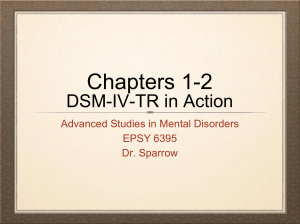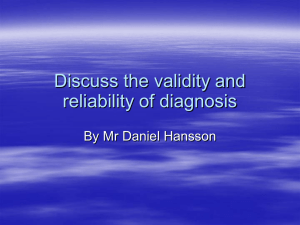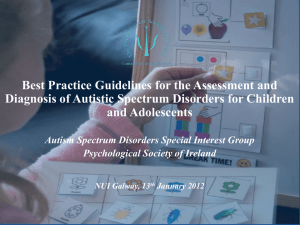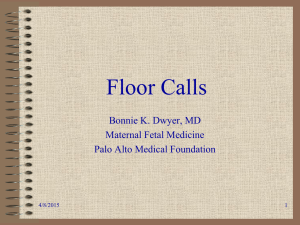View Presentation - Campaign For Quality
advertisement
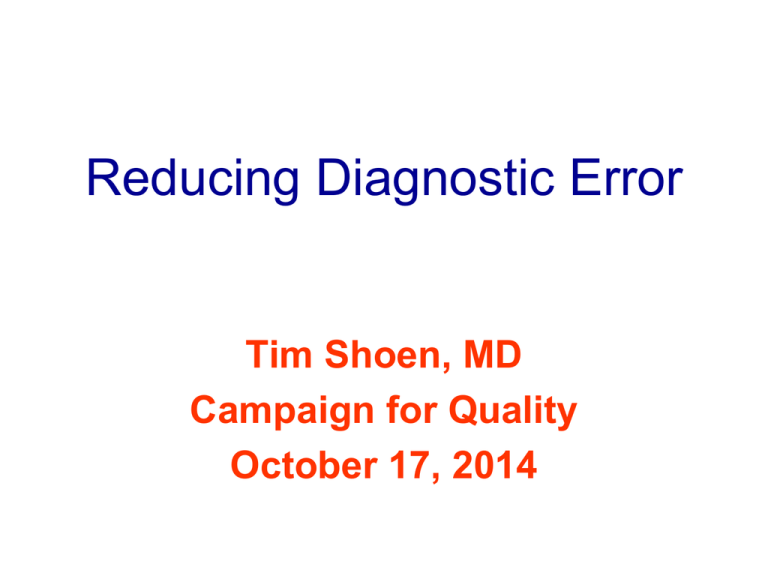
Reducing Diagnostic Error Tim Shoen, MD Campaign for Quality October 17, 2014 Disclosure No financial interest to disclose Thanks to Mark Graber, MD, President, SIDM. Sue Sheridan Wall Street Journal The Biggest Mistake Doctors Make Misdiagnoses are Harmful and Costly But they're often preventable Laura Landro November 17, 2013 Patient Safety Awareness 2014 Creating a world where patients and those that care for them are free from harm. www.npsf.org Society to Improve Diagnosis in Medicine We envision a world where diagnosis is accurate, timely, and efficient. www.improvediagnosis.org Gregory House, MD Objectives • Review Incidence • Contribution of Cognitive and System factors • Improvement Efforts Diagnosis The satisfaction of solving The Riddle…is every doctor’s measure of his own abilities; it is the most important ingredient in his professional self-image. Dr. Sherwin Nuland How We Die 1994 Human Error • Skill Based – error rate 1:1000 • Rule Based – error rate 1:100 • Knowledge Based – error rate 1:2 Preventable Harm Error Adverse Event Diagnostic Error • Delayed Diagnosis • Missed Diagnosis • Wrong Diagnosis Estimates of Dx Error Rate Expert Patient Survey Second Reviews Look backs A. Elstein: 10-15% One third relate a Dx error affected themselves, family Radiology and Pathology: 2-5% cancers missed 30% of subarachnoid hemorrhage misdiagnosed; 39% of dissecting AAA delayed diagnosis; A third of neurological diagnoses wrong or likely wrong Autopsy Major unexpected discrepancies that would have changed the management are found in 10-20% Estimates Diagnostic Error Rate Trauma 8% of pts have missed injuries General ER .6% of 5000 admitted pts at Wayne State MI 2-3% of pts sent home have an MI; 90% of pts admitted don’t have an MI or ACS Liability 47% claims high severity cases alleged Dx related Outpatient Clinic 1:20 patients experience dx error each year Diagnostic Errors • Are common and cause enormous harm • Estimates 40,000-80,000 annual deaths • Overlooked with emphasis on system improvement • Measurement tools lacking Etiology of Diagnostic Error Both System and Cognitive Errors 46% No Fault Error Only 7% System Error Only 19% Cognitive Error Only 28% Cognitive Errors: 320 Faulty Knowledge 3% Faulty Data Gathering 14 % Faulty Synthesis 83 % Diagnostic Errors • Are common and cause enormous harm • Most errors involve both system and cognitive components. • Cognitive errors most often reflect problems using intuition Cognitive Psychology Brain Hard wiring Ambient conditions/Context Task characteristics Age and Experience Affective state Gender Personality RECOGNIZED Patient Presentation Pattern Processor Dual Process Model of Clinical Reasoning 1 Pattern Recognition Repetition NOT RECOGNIZED Education Training Critical thinking Logical competence Rationality Feedback Intellectual ability 2 Executive override Dysrationalia override Calibration Diagnosis Heuristic and Bias • Confirmation Bias • Availability • Anchoring COGNITIVE ERRORS Most common: • • • • Premature closure (39) Faulty context generation (26) Faulty perception (25) Failed heuristic (23) How can we make diagnosis more reliable ? Problems • • • • Faulty context Premature closure Failed heuristic Framing errors Solutions • • • • • Consider the opposite Crystal ball experience Reflection Be comprehensive Learn the antidotes DX Reasoning The PROBLEM: COMPLEXITY The SOLUTION: NOT training; NOT redesign A Checklist The B-17, and its checklist, flew the next 1.8 million miles without an accident. The military obtained over 13,000, and the B-17 was the workhorse of the Allied air force in World War II. Complexity in Medicine 13,000 known diseases, syndromes, injuries 4,000 possible tests 6,000 medications, treatments, and surgeries The average limits of human working memory: 7 discrete items The Surgical Checklist • WHO sponsored study in 8 countries • 19 item checklist: – Sign in + Time out + sign out • Evaluated in 3733 operations: • Results: – Major complications fell from 11 to 7% – Death rate fell from 1.5 to 0.7% (p = 0.003) Haynes et al. NEJM 360: 491-9, 2009 A Checklist for Diagnosis Obtain YOUR OWN history Perform a focused, purposeful exam Take a “Diagnostic Time Out” Was I comprehensive ? Did I consider the inherent shortcomings of using my intuition (heuristics) ? Was my judgment affected by bias ? Do I need to make the diagnosis now or can it wait ? What’s the worst case scenario? Embark on the plan, but ENSURE FOLLOW-UP & FEEDBACK Structured Reflection V ascular I nfections & intoxications T rauma & toxins A uto-immune M etabolic I diopathic & iatrogenic N eoplastic C ongenital C onversion (psychiatric) D egenerative E ndocrine Possible Solutions • National Agenda • Research • Health IT • Clinical Reasoning Education Summary • Diagnosis errors are common and harmful • High quality healthcare requires high quality diagnosis • Diagnostic errors are costly • Healthcare Organizations are well positioned to lead efforts to reducing these errors Case Studies • Maine Medical Center – Physician Reporting • SoCal Kaiser Permanente – Electronic Records to Trace Diagnostic Error Reference Reference Questions? Tim Shoen, MD shoen7754@aol.com Subject: Dx Error
